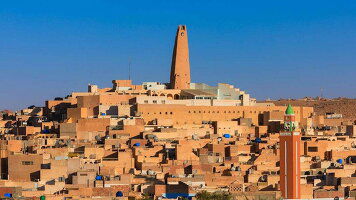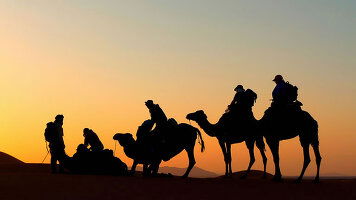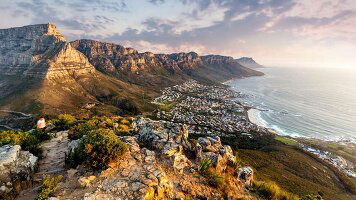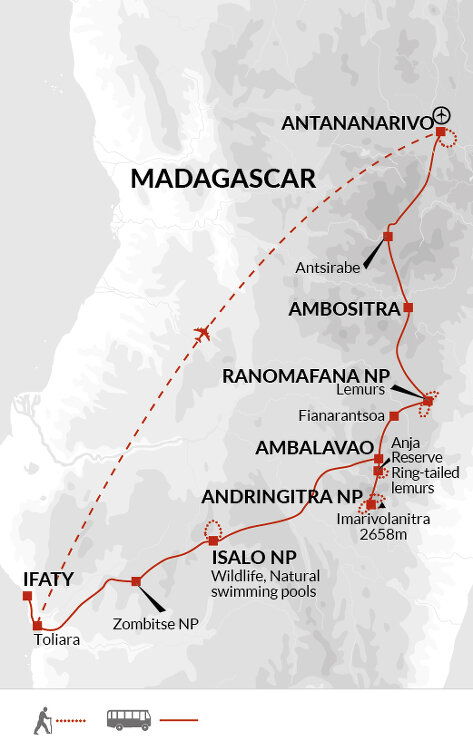
Overview
Itinerary
Our tour starts today in Madagascar's capital, Antananarivo (also known as Tana). Built over 12 hills, the city is a tapestry of old and new with French colonial buildings, modern offices and apartment blocks vying for space.
For those arriving in time, our tour leader plans to meet you in the hotel reception at 6pm for a welcome meeting and for those that wish, there is the chance to go out for dinner. There are no activities planned today, so you're free to arrive in Antananarivo at any time. If you'd like an airport transfer today, you'll need to arrive at Ivato International Airport (TNR) which is around a 15-minute drive from the hotel. Should you miss the meeting, your leader will inform you of any essential information as soon as you catch up.
If your flight arrives earlier in the day, you might like to get to know Tana at your own pace. Take a walk to soak up the capital's colourful landscape, its houses stacked one upon the other down the sloping hills of the highlands. Stay: Hotel Au Bois Vert (Comfortable)
This morning, we'll have an early start for our long journey south by charter bus via Antisarabe to Ambositra. Our drive will take us through subtropical highlands, the volcanic field around Antisarabe, terraced rice paddies and village communities typical of the Malagasy highlands.
We'll aim to leave around 8am, drive to Antsirabe in the central highlands for lunch and then continue southwest to Ambositra. On arrival we'll head into town, purchase provisions and drinks for the evening and, time permitting, see the local market and wood carving shops (Ambositra is the centre of the woodcarving tradition of Madagascar).
Tonight, we'll visit a local development guest house to enjoy a traditional Malagasy meal and see a folk dance. By visiting here, we directly support an important base for the development of health projects, agriculture and the empowerment of women within the local community.
We'll return to Ambositra for our overnight stay. Stay: Artisan Hotel (Comfortable) (B/L/D)
Continuing south, we'll drive for a further four hours to Ranomafana. Once we arrive at the park, we'll have a picnic lunch and then trek from the park entrance to the campsite in the primary rainforest keeping an eye out for local wildlife including lemurs along the way. If we're extremely lucky, we'll see the endangered golden bamboo and greater bamboo lemurs. It was the discovery of the rare golden bamboo lemur that persuaded the government to create Ranomafana National Park in 1986. Please note, the terrain is hilly rainforest and the walk is mainly on unmade forest trails.
Today's moderate 5 kilometre/3.10 mile walk is expected to take around 3 hours with 230 metres/755 feet of ascent. Stay: Manja Hotel (Simple) (B/L/D)
Ranomafana is one of Madagascar's most spectacular national parks. The hills are covered in primary and secondary cloud and rainforest, and there is a great diversity of flora and fauna including 12 species of lemur and over 115 species of birds, some of which are endemic to the area. There are also many small streams and waterfalls running through the park, joining the Namorona River as it flows off the highlands and into the valley.
This morning, we'll take another wildlife walk into the forest hoping to see more animal species, including the black-and-white ruffed lemur which can only be found in this primary forest area. We'll then hike out of the forest area along the Varijatsy Trek Circuit to the village of Ranomafana on the banks of the Namorona Rive finishing up at the thermal baths and swimming pool - the name Ranomafana locally means 'hot water'.
Today's 12 kilometre/7.50-mile walk is expected to take around 5 hours with 800 metres/2625 feet of ascent. As yesterday the terrain is hilly rainforest, and the walk is mainly on unmade forest trails. Stay: Manja Hotel (Simple) (B/L/D)
Today we'll travel to Ambalavao via the ancient royal city of Fianarantsoa. Ambalavao is a beautiful town, the houses in the 'Old Town' are brightly coloured with steep tiled roofs and wooden balconies. It is also a lively market town, home to the largest cattle market in Madagascar. After an optional lunch, we'll visit the nearby Anja Reserve, a local community reserve, where we hope to see ring-tailed lemurs before returning to Ambalavao for the evening. Stay: Hotel Bourgainvillia (Comfortable) (B)
After breakfast, we'll travel by 4WD to Andringitra National Park where we'll spend the next 3 days. On arrival, we'll trek with porters east through several small villages to the first forest campsite, where we have a picnic lunch. The park scenery is stunning, encompassing high mountains, granite outcrops and deep valleys, and supports rainforest, mountain forest and high-altitude meadow vegetation. As a consequence, it's one of the most biodiverse areas of Madagascar with over 1000 species of plants, 100 species of birds, 50 species of mammals (including 13 of lemurs) and 55 species of frogs. However, the park covers a large area and much of it is grassland meadows (it's covered in flowers including orchids December to April) so the wildlife isn't always easy to see. This is a small, basic campsite in a forest clearing with simple facilities and no showers, water is taken from the nearby stream. After dinner, we'll take a nocturnal nature walk looking for local animal nightlife in the forest.
Today's 7 kilometre/4.30-mile walk is expected to take around 4 hours with 300 metres/984 feet of steep ascent. The path passes through local villages and through fields before meeting the edge of the forest area at the campsite. Stay: Imaitso Campsite (Simple) (B/L/D)
Starting early, we'll make a wildlife walk, looking for birds and lemurs, before we begin our trek up to the park's highest campsite, Andriampotsy. We'll gain altitude on this trek as we pass through the Imaitso forest and arrive at a meadow plateau at the foot of the main Andringitra granite outcrop. We'll have a picnic lunch on the way up and then follow the trail past several streams to the campsite, the base camp for the climb to the highest point of the reserve, Pic Imarivolanitra. The campsite is basic with one long drop toilet and only bucket washing available, our cook will provide us with an evening meal before we turn in for the night.
Today's 10 kilometre/6.20-mile walk is expected to take around 6 hours with 520 metres/1706 feet of ascent, mainly uphill along unmade tropical forest paths. Stay: Andriampotsy Campsite (Simple) (B/L/D)
Today, we'll walk up between a series of granite boulders to the summit of Imarivolanitra (2,658m/8721 ft), the highest point in southern Madagascar. It's a fairly steady climb on a well-managed path and the views from the top of this mountain down over the park are breathtaking. We'll then descend along the same paths via last night's campsite to a lower site, another basic campsite with one long drop toilet and water is taken from the nearby stream.
Today's challenging 18 kilometre/11.20-mile walk is expected to take around 9 hours with 600 metres/1968 feet of ascent and 900 metres/2953 feet of descent. It is a steady ascent along narrow mountain paths followed by a descent on similar paths down through tropical forest. Stay: Iantaranomby Campsite (Simple) (B/L/D)
After walking to the park entrance, we'll return by 4WD to Ambalavao, and then head southwest by charter bus to Isalo National Park where we'll stay in Isalo Ranch Hotel. This hotel is on the edge of the Isalo sandstone massif where the dry forest is home to sifaka, ring-tailed lemur and brown lemur.
For the next two nights, we'll stay at an eco-lodge in simply furnished traditional thatched roofed bungalows. From the hotel, we can see the sandstone hills that have been eroded by nature to form deep gorges and bizarre shapes. Please note that the electricity and hot water are solar generated and can be unreliable at times. The hotel has an on-site restaurant, bar and outdoor swimming pool.
Today's 7 kilometre/4.30-mile walk is expected to take around 3 hours with 500 metres/1640 feet of descent. We descend down to the park entrance on unmade forest trails and access roads. Stay: Isalo Ranch Hotel (Simple) (B/L/D)
Isalo offers a totally different landscape from either Ranomafana or Andringitra. The main massif is a huge area of sandstone eroded into deep gullies on the eastern side. There are patches of dry forest throughout the reserve which are home to lemur groups although they are shy and rarely seen. The temperatures are much hotter and plant life reflects this with moisture-retaining species such as aloes and the extraordinary dwarf baobabs. After a morning wildlife trail, we'll walk with our porters through the sandstone massif of Isalo to natural swimming pools and return to Isalo Ranch.
Today's 8 kilometre/5.0 mile walk is expected to take around 4 hours with 250 metres/820 feet of ascent, along uneven sandstone paths. Stay: Isalo Ranch Hotel (Simple) (B/L/D)
This morning, we'll drive west to Toliara. En route, we'll stop at Zombitse National Park, which despite years of slash-and-burn farming in the area, hosts an area of dry deciduous forest. This harbours a wide variety of wildlife including several lemur species and the elusive fossa (a cat-like mammal endemic to Madagascar), as well as many birds and reptile species. Throughout the forest are magnificent baobab trees. From Toliara, we'll continue to Ifaty Beach, a small resort on the west coast, our base for the next 2 nights.
Today's 4 kilometre/2.50-mile walk is expected to take around 2 hours with 250 metres/820 feet of descent, along uneven sandstone paths. Stay: Bamboo Club (Comfortable) (B)
Today is free to relax or explore the area. Ifaty Beach is a huge sandy bay which looks out over a lagoon protected by a barrier reef up to 7 kilometres/4.40 miles from the shore. Traditional fishing villages are scattered along the bay and fishing is still done in sail-powered outrigger canoes. There is an excellent forest walk in the Reniala Reserve just inland from the beach area, where strange spiny forest can be found and some of the most attractive of the endemic bird species, such as the long-tailed ground roller, sub-desert mesite and sickle-billed vanga.
Today's optional 2 kilometre/1.20-mile walk is expected to take around 2 hours. Stay: Bamboo Club (Comfortable) (B)
Depending on the flight schedule, we'll either have a very early start or a more relaxed morning in Ifaty, our tour leader will advise what time we need to leave.
We'll fly from Toliara back to Antananarivo airport from where it's a short transfer to our hotel. As the time of the domestic flight varies, the rest of the day is free to relax. Stay: Hotel Au Bois Vert (Comfortable) (B)
This morning we transfer to Ambohidrabiby Hill, on the outskirts of Antananarivo, by bus and take a gentle walk to the top of this sacred hill. The walk takes us through local highland villages and rice paddies, learning about local silk weaving along the way before returning to Antananarivo in the afternoon.
Today's 6 kilometre/3.70 miles walk is expected to take around 3 hours with 250 metres/820 feet of ascent, along simple footpaths. Stay: Hotel Au Bois Vert (Comfortable) (B)
The trip ends after breakfast at our hotel in Antananarivo.
There are no activities planned today, so you're free to depart from Antananarivo at any time. If your flight is departing later in the day, luggage storage facilities are available at our hotel. If you'd like an airport transfer today, you need to depart from Ivato International Airport (TNR) which is around a 15-minute drive from the hotel. (B)
Trip Inclusions
- Search for Madagascar's unique wildlife from lemurs to chameleons
- Walk through villages and interact with the friendly and hospitable local people.
- Walk through different landscapes: cloud and rain forest, granite hills and high meadows
- For those who are fit and active, these moderate walks are normally on good paths and tracks at low altitude. Days may include some fairly demanding ascents and descents, so previous experience is preferable but not essential.
- Accommodation, itinerary and inclusions subject to change.
- Price is for land, cruise and internal flights as specified. Flights not specified are not included
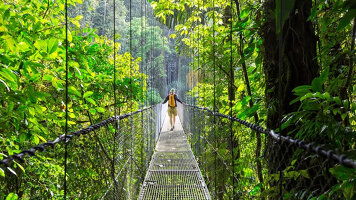
Launching in 1981, Explore Worldwide offer trips from over 130 countries - from classic small group tours. Read more
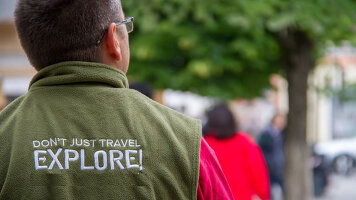
Explore's leaders are more than just your typical guide. They're your local expert are are passionate about sharing their expertise with you. Read more
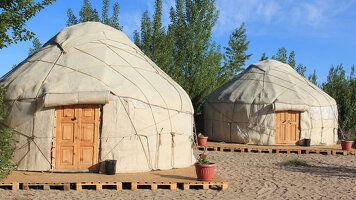
The places Explore stay are every bit as important as the sights they visit and the things you do. Read more
Brochure
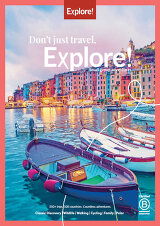
Explore Worldwide Small Group Adventures (2025-26)
Dates & Pricing
 USD
USD
A definite departure means minimum numbers have been reached for this departure to operate. Your Global Journeys Travel Advisor will check the availability of your departure date when you Inquire. Additional savings may apply. T&C’s apply.
Tour & cruises prices are per person. Prices shown have savings applied, are subject to availability and may be withdrawn at any time without notice. Pricing and trip details are correct at this point in time, however are subject to confirmation at the time of booking and are subject to change by Explore. For cruise itineraries, cabin images are sourced from the cruise-line and should be treated as indicative only. Cabin inclusions, upholsteries and room layout may differ to the image(s) shown depending on the ship selected and your sailing dates.




